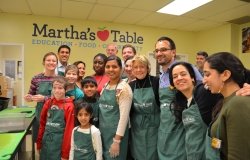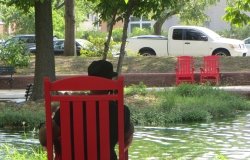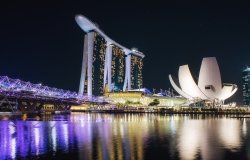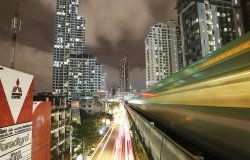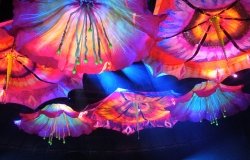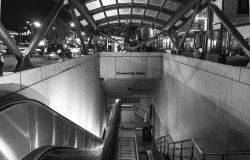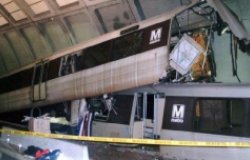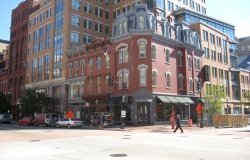Making Community Work: the Importance of the Performing Arts
Resilience and adaptability increasingly are seen as essential for community well-being, particularly in the face of growing challenges and dilemmas posed by natural and man-made misfortune. Resilience, in turn, requires expansive social capital and vibrant civic life.

More than two decades ago, in 1993, Harvard Government Professor Robert Putnam published his now classic study Making Democracy Work: Civic Traditions in Modern Italy. Trying to answer the question why northern Italian cities developed vibrant civic traditions which came to support the growth of democratic institutions and southern Italian cities did not, Putnam was surprised to find a strong correlation between civic health and choral societies. Putnam masterfully argued that choral societies emerged from the same broad reservoir of social capital that is required to support civic vitality.
Appearing just as countries throughout the former Communist world were struggling to create new democracies, Putnam’s work became something of a Holy Grail for promoters of a new political order. The problem, however, was that Putnam’s work failed to sufficiently explain how such civic virtue and social capital could be created in the first place.
Perhaps hard-nosed democracy advocates pursuing measurable advances towards institutionally-bounded representative institutions considered music little more than white noise. If so, they may have missed part of a solution to Putnam’s seemingly unanswered challenge. Song, after all, has bound humans together for millennia and the social interaction required to create vocal beauty can be transferred to other activities. Choral societies are not just a reflection of civic health, but may be central to its origins.
The significance of social capital for civic well-being is more than theoretical conjecture. A growing body of evidence drawn from the responses to such recent disasters as Hurricane Katrina and Superstorm Sandy suggests that those communities with the highest stores of social capital before communal trauma recover most quickly following both man-made and natural disasters. Such capital, in turn, does not require deep knowledge of one another so much as a casual sociability which allows neighbors and colleagues to turn to one another in times of crisis. The performing arts encourage just such a geniality by bringing together audiences and performers to share a moment of conviviality.
The power of the performing arts to create a sense of shared community can be seen in contemporary Washington, D.C. The city has suffered throughout its history from a stark, deeply embedded racial divide; class separations between those who have, and those who have not; and most recently, tensions between long term residents and new comers who increasingly displace those who have come before. Moments and places shared by Washingtonians of all races, ages and beliefs remain unhappily rare. Those pauses in city life where they exist --as is evident in three particularly successful performing arts centers – deserve celebration.
Dance Place: During the mid-1970s, native Washingtonian and aspiring dancer, choreographer and teacher Carla Perlo was searching for a way to pursue her love of dance while remaining in her home town. Renting a loft in 1978 in the as-yet-emerging Adams Morgan neighborhood, she joined forces with Steve Bloom to open Dance Place, a touring educational and Performing Arts Company that performed at the region’s public schools. Immediately becoming a friendly hub in an increasingly vibrant dance community, Dance Place became an energetic catalyst both teaching studio and creative dance and bringing renowned national and international performers to the Nation’s Capital. In 1986, as a fresh wave of gentrification swept across Adams Morgan, Perlo lost her lease. Concluding that she could only protect her company by purchasing space, she scoured the city for an inexpensive yet spacious home, Dance Place eventually ended up in an old industrial building squeezed between auto repair shops that backed up on a heavily-used rail line that had recently provided the right-of-way for the Washington Metro’s Red Line. Just a couple of minutes’ walk from Metro’s Brookland – Catholic University Station, Perlo had secured her future, albeit in a rough and tumble neighborhood that frightened many of her students. Working assiduously to reach out to neighborhood residents and children, Perlo emerged as a focal point for community activities reaching far beyond dance. Booking leading dance companies from around the world – and establishing a ground-breaking annual DanceAfrica DC festival – she put a previously unknown corner of Northeast DC on the international dance map. When the gentrification tsunami reached Brookland a few years ago, developers had to deal with her rather than the other way around. She masterfully converted a massive real estate development down the street into an opportunity to upgrade her performance studios and education center.
Thearc: In the spring of 2006, a coalition of major Washington companies, non-profit organizations, and businesses opened the doors of the Town Hall Education Arts and Recreation Campus (THEARC) in one of the city’s poorest “east of the [Anacostia] river” neighborhoods in Ward 8. Led by inspiring educator and community developer Edmund Fleet, THEARC provided a $27 million state-of-the art performing, rehearsing, and teaching facility to Washington’s most isolated residents. Working with William C. Smith & Co. as well as such partners as the Boys & Girls Clubs of Greater Washington, Covenant House Washington, NFL Playground, KABOOM!, several dozen foundations and major corporations and the DC Department of Housing & Community Development, Fleet has created the city’s liveliest arts center in its least likeliest location. In addition to working with community residents, THEARC has become a favored performance venue for local standout ensembles such as The Washington Ballet and National Symphony as well as touring companies from around the world. On any given day, THEARC hosts performers visiting from the four corners of the globe while offering underserved children and families dance classes, music instruction, fine arts, academic, and recreational programs as well as social services, mentoring, and after school care at no – or affordable – cost.
 Westminster Church: A decade-and-a-half ago, the Reverend Brian Hamilton asked the Congregation of Westminster Presbyterian Church a few blocks from the waterfront in Southwest DC if he could organize weekly jazz performances every Friday evening. His goal was to provide an entertaining night out for the community’s retirees and to attract an audience from the diverse corners of an all-too-divided city. Charging a minimal $5 admission fee – and offering scrumptious down-home dinners in the basement – Hamilton made music available to all. Under the direction of former Redskin and singer Dick Smith, “Jazz Night in Southwest” quickly became a favorite venue for musicians who valued the enthusiastic and knowledgeable audience, the comforting meals, and a three hour gig that stimulated improvisation. A few years later, Hamilton initiated a similar “Blues Monday” series. Performances include aspiring students and world-recognized veterans, school teachers and military band leaders. The audiences attract as diverse an array of Washingtonians as can be found anywhere, with identities being checked at the door. The daughter of a Wall Street titan may find herself sitting next to Billie Holliday’s drummer; the chief of staff of a powerful Congressional committee might be exchanging stories with a retired dancer who hoofed across the celebrated stages of the Apollo in New York and the Howard in DC; while a twelve-year old trumpet prodigy discovers the wisdom of James Brown’s drummer. More than any other moment in the week, DC becomes an unpretentious community overflowing with social capital from six to nine every Friday and Monday evening.
Westminster Church: A decade-and-a-half ago, the Reverend Brian Hamilton asked the Congregation of Westminster Presbyterian Church a few blocks from the waterfront in Southwest DC if he could organize weekly jazz performances every Friday evening. His goal was to provide an entertaining night out for the community’s retirees and to attract an audience from the diverse corners of an all-too-divided city. Charging a minimal $5 admission fee – and offering scrumptious down-home dinners in the basement – Hamilton made music available to all. Under the direction of former Redskin and singer Dick Smith, “Jazz Night in Southwest” quickly became a favorite venue for musicians who valued the enthusiastic and knowledgeable audience, the comforting meals, and a three hour gig that stimulated improvisation. A few years later, Hamilton initiated a similar “Blues Monday” series. Performances include aspiring students and world-recognized veterans, school teachers and military band leaders. The audiences attract as diverse an array of Washingtonians as can be found anywhere, with identities being checked at the door. The daughter of a Wall Street titan may find herself sitting next to Billie Holliday’s drummer; the chief of staff of a powerful Congressional committee might be exchanging stories with a retired dancer who hoofed across the celebrated stages of the Apollo in New York and the Howard in DC; while a twelve-year old trumpet prodigy discovers the wisdom of James Brown’s drummer. More than any other moment in the week, DC becomes an unpretentious community overflowing with social capital from six to nine every Friday and Monday evening.
These remarkable Washington institutions reveal partial answers to the question of how the social capital required to make democracy – and community – work comes into being, including: leadership; bringing global and local together; and recognizing that assets are different from profits.
Leadership Matters: The stories of Dance Place, THEARC and Westminster Church begin with their visionary founders and the sustaining leaders they have nurtured around them. Social capital must be created and promoted over time, requiring the long-term engagement of civic leadership.
Link Global and Local: Dance Place, THEARC, and Westminster Church take great pride in presenting performers from the District of Columbia and the Washington metropolitan region. These are not just “local” artists as many appear around the world and around the country bringing together global and local into a single continuum.
Assets are Different from Profits: Dance Place, THEARC, and Westminster Church are not commercial venues – and could not succeed commercially. All three nonetheless add great value to Washington, including the very social capital that will be so necessary should the city and region confront calamity.
Resilience and adaptability increasingly are seen as essential for community well-being, particularly in the face of growing challenges and dilemmas posed by natural and man-made misfortune. Resilience, in turn, requires expansive social capital and vibrant civic life. Community vitality requires increasingly diverse neighbors come to know one another, even if only casually. As these Washington examples demonstrate, the shared enjoyment provided by the performing arts promotes a virtuous cycle which enables communities to move forward in the face of adversity.
About the Author

Blair A. Ruble
Former Wilson Center Vice President for Programs (2014-2017); Director of the Comparative Urban Studies Program/Urban Sustainability Laboratory (1992-2017); Director of the Kennan Institute for Advanced Russian Studies (1989-2012) and Director of the Program on Global Sustainability and Resilience (2012-2014)

Urban Sustainability Laboratory
Since 1991, the Urban Sustainability Laboratory has advanced solutions to urban challenges—such as poverty, exclusion, insecurity, and environmental degradation—by promoting evidence-based research to support sustainable, equitable and peaceful cities. Read more


